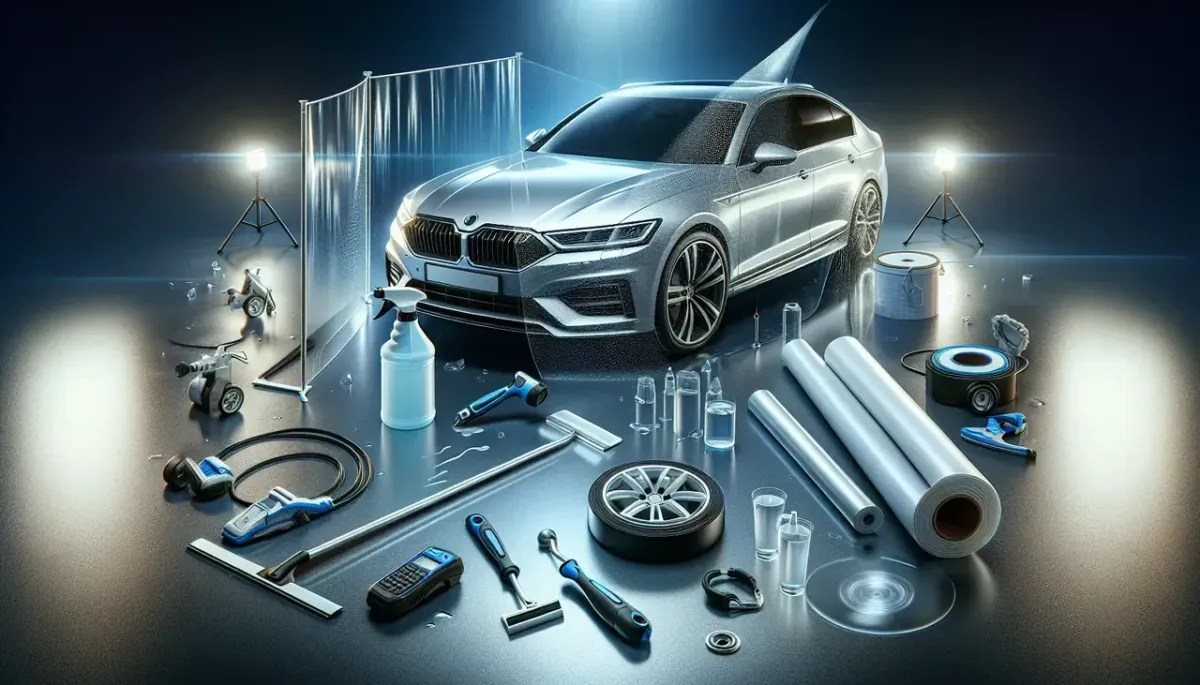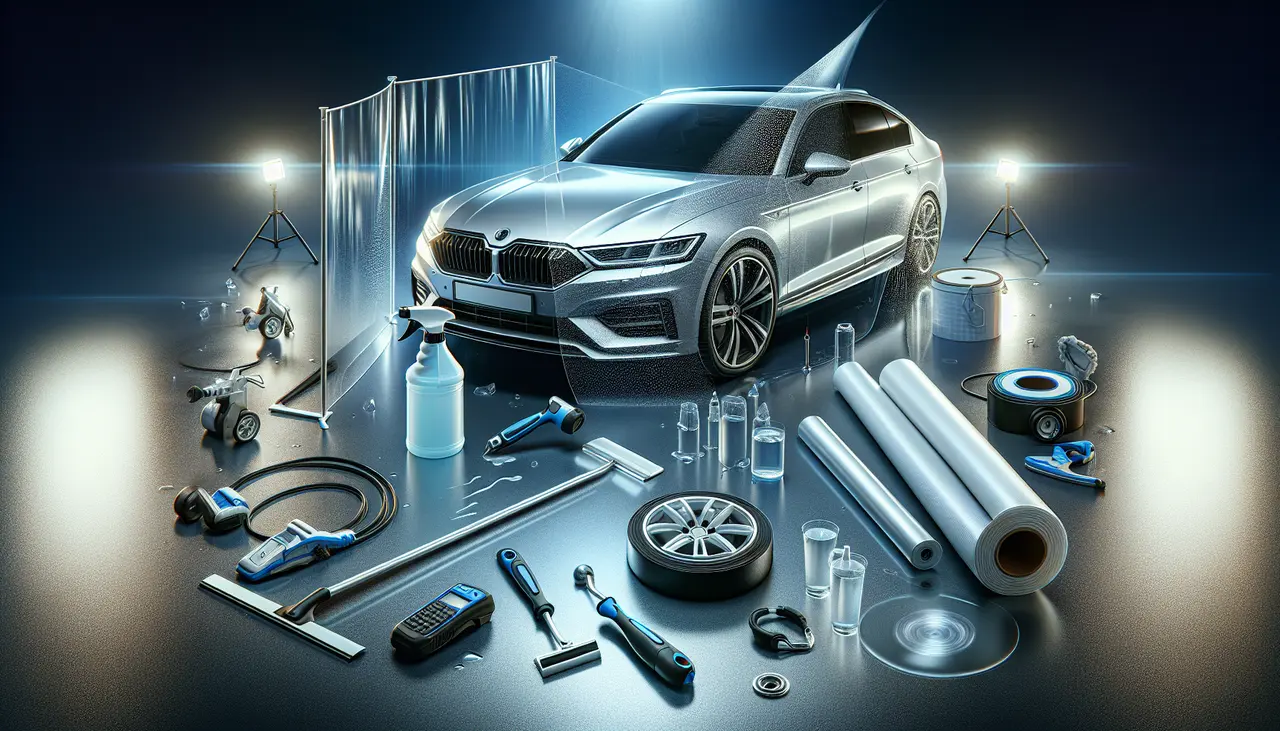My Awesome Detailer, LLC
My Awesome Detailer, LLC's Blog
"Auburn Alabama's #1 Resource for Ceramic Coating & Auto Detailing Information"

The Ultimate Guide to Protecting Your Vehicle with Paint Protection Film
Introduction to Paint Protection Film
Paint Protection Film, or PPF, is like a superhero cape for your car. Imagine an invisible shield that wraps around the car's body, protecting it from scratches, chips, and stains that come from everyday mishaps. This thin yet durable film is applied to the exterior of vehicles to safeguard them against the elements. Whether it's from road debris, rock chips, bug splatter, or harmful UV rays, PPF keeps your car looking fresh off the lot. It's not magic, but it's close. Think of PPF as an investment in maintaining your vehicle's beauty and value. It's about giving your ride a fighting chance against the wear and tear of the road. In simple terms, if you love your car and want to keep it looking sharp, Paint Protection Film is the way to go.

What is Paint Protection Film and How Does It Work?
Paint protection film is like a superhero cape for your car. It's a thin, strong piece of clear urethane material that guards your vehicle's paint against chips, scratches, stains, and the sun's harsh rays. Think of it as an invisible shield that helps keep your car looking fresh and new. This film sticks right onto your car's body, blending in so well that you won't even know it's there. It works by absorbing or deflecting harmful things that would otherwise damage your paint job. Plus, it's got a cool self-healing feature. Small scratches will disappear with a bit of heat from the sun or warm water. It's a smart move if you want to keep your car looking great and maintain its value over time.
The Benefits of Applying Paint Protection Film to Your Vehicle
Paint Protection Film, or PPF, acts like your car's superhero, blocking away all the nasty stuff the roads throw at it. Think of it as a clear shield that keeps your car's paint job looking fresh off the lot. Here's why slapping some of this magic on your ride is a good move:
First, it fights off scratches and scuffs. Your car faces a lot from stones, keys, and even those annoying shopping carts. PPF takes one for the team, keeping your paint underneath neat and scratch-free.
Second, it guards against UV rays. Just like sunscreen for your skin, PPF shields your car's paint from the sun, stopping it from fading and keeping its vibrant color for longer.
Third, it's low maintenance. Once applied, you don't have to worry about waxing your car all the time. Just a simple wash and it stays looking shiny and new.
Also, it boosts your car's resale value. When it's time to part ways with your vehicle, a pristine paint job can make all the difference in how much cash lands in your pocket.
Lastly, it gives your car a glossy finish. Besides all the protective benefits, PPF adds an extra level of shine to your vehicle, making it turn heads wherever it goes.
In short, PPF is a smart choice for any car owner who wants to keep their vehicle looking its best while fighting off everyday wear and tear.
Types of Paint Protection Film
There are mainly three types of paint protection film (PPF) to consider for safeguarding your vehicle's exterior: clear bra, ceramic coating, and vinyl wrap. Clear bra is the most popular choice. It's a transparent, durable film that guards against chips, scratches, and stains. It doesn't alter the color of your car and is almost invisible. Ceramic coating adds a hard layer on top of your paint, making it easier to clean and adding a glossy finish. However, it's less effective against physical impacts. Vinyl wrap covers your entire vehicle or specific parts with a thin, vinyl film. It's great for changing the appearance of your car and offers moderate protection against damage. Each has its pros and cons, so your choice should match your protection needs and aesthetic preferences.
How to Choose the Right Paint Protection Film for Your Vehicle
When choosing a paint protection film for your vehicle, focus on quality and compatibility. High-quality films can guard against scratches, weather elements, and minor abrasions, keeping your car looking new. Start by checking the film's material. Polyurethane films are top-notch, offering flexibility and durability. Next, consider the thickness. Thicker films provide better protection but may be more visible. Finish options matter too – glossy films enhance your car's shine, while matte finishes give a sleek, modern look. Don't skip on UV protection; it prevents yellowing and prolongs the film's life. Lastly, the warranty speaks volumes about its longevity and quality. A longer warranty means the manufacturer stands behind their product. Remember, the best film balances protection, aesthetics, and value.
The Installation Process of Paint Protection Film
The installation of paint protection film is a straightforward yet detailed process. First off, your car gets a thorough wash. Every speck of dirt must go because even the smallest grain can ruin the smooth finish of the film. Next, the car's surface gets meticulously dried. Any moisture trapped under the film could lead to imperfections. Then comes the precise job of cutting the film. Professionals use a template specific to your vehicle's make and model to ensure the film fits perfectly. No guesswork here.
Now, the real action begins. The installer applies a solution to the car's surface to help the film glide and adjust into place without hassle. This is the stage where expertise shines. The installer squeegees out bubbles and ensures the film sticks flawlessly, contouring every curve and corner of your car. Finally, a post-installation inspection checks for any missed spots or edges that need a touch-up.
This process may sound simple, but it requires a steady hand, an eye for detail, and patience. The result? Your car's paint isn't just protected; it's practically armored against scratches, chips, and UV damage, keeping your vehicle looking newer for longer.
Maintenance Tips for Keeping Your Paint Protection Film in Top Condition
Keeping your paint protection film (PPF) in top condition doesn't demand much, but it does ask for consistent attention. Think of it as caring for your skin; you wouldn't go out in the sun without protection, right? Similarly, your car's PPF needs protection, too. First off, wash your car regularly. Dirt, dust, and bird droppings aren't just unsightly; they can eat away at the film over time. Use a mild, soap-free cleaner and a soft cloth or sponge to avoid scratches. Avoid high-pressure washes directly on the edges of the film, as it can cause it to peel.
Secondly, monthly waxing is a friend to your Puddle Protection Film. It adds an extra layer of protection and keeps the film from looking dull. However, steer clear of waxes containing dyes or petroleum products, as they can damage the film.
Lastly, watch where you park. Just like the skin, prolonged exposure to direct sunlight can discolor and damage the film. Whenever possible, opt for shaded or covered parking spots.
Remember, the key to keeping your PPF looking pristine is regular care and attention. A little effort goes a long way in preserving that showroom shine.
Common Myths and Misconceptions About Paint Protection Film
Many think paint protection film (PPF) will surely change the color of their vehicle or it's just for fancy cars. Wrong. PPF is a clear layer that doesn’t change your car’s color. It protects it from scratches, chips, and sun damage, making it a good pick for any vehicle. Some say it’s too pricey. Consider this: it’s an investment to keep your car looking newer for longer. Over time, it saves you money on repairs and touch-ups. Others believe applying PPF will void the car manufacturer's warranty. Not true. If properly installed by professionals, it won’t impact your warranty. Don't let these myths deter you from keeping your vehicle in top-notch condition.
Cost Considerations and Investment in Paint Protection Film
Paint Protection Film (PPF) isn't just an extra expense; it's an investment in your vehicle's longevity and looks. Think of it as a shield that guards against scratches, dents, and the sun's harmful rays. Now, let's talk numbers. The cost of PPF can vary widely depending on a few key factors. First, the size of your vehicle matters. A compact car will cost less to cover than a large SUV. Expect to shell out anywhere from $1,500 to $7,000 for full PPF coverage. It's a broad range, but it gets narrower when you start looking at specifics like the brand of film, the expertise of the installer, and your car's contours. High-quality films that promise durability and hydrophobic properties are on the upper end of the scale. Don't forget, the skill of the person applying the film can make a huge difference. A seasoned pro might cost more upfront but think about the long-term benefits. Precise application means better protection, fewer peeling issues, and a top-notch finish. In the grand scheme, investing in a good PPF job protects your ride from the everyday wear and tear of the road, potentially saving you money on paint repairs in the future. So, while the initial price tag may give you pause, weigh it against the cost of potential bodywork and lost resale value without protection. In the end, PPF isn't just about maintaining your car's appearance—it's about preserving its value too.
Conclusion: Ensuring Your Vehicle's Longevity with Paint Protection Film
Wrapping up, getting paint protection film might look like a big pocket pinch now, but it’s an investment into your vehicle’s future. This thin, invisible cloak not only shields your ride from scratches and chips but also keeps it looking newer for longer. By protecting your car’s paint, you’re also preserving its resale value. So, when it's time to sell, a car that’s been shielded with PPF will likely fetch a higher price than one that’s been left to wrestle with the elements. Remember, the cost of applying paint protection film is peanuts compared to the expense of a full repaint or the loss in value from wear and tear. In short, if you love your vehicle and want to keep it minty fresh for as many years as possible, PPF isn’t just an option; it’s a necessity.

My Awesome Detailer was founded with one mission: to bring elite-level vehicle protection and detailing to Auburn, AL and beyond.
Since day one, our focus has been delivering long-lasting paint enhancement, value retention, and top-tier appearance protection —with zero compromises.
We believe that true automotive care starts with clear communication and customized solutions, tailored to the specific needs of each vehicle and owner. From professional-grade ceramic coatings and self-healing paint protection film to precision paint correction and full-vehicle detailing, every service we offer is designed to elevate, protect, and preserve your investment.
At My Awesome Detailer, you don’t just get a clean car—you get long-term peace of mind and a finish worthy of a showroom spotlight.
Contact Info & Address
2709 Frederick Road, Opelika AL 36801
(334) 650-6499
Working hours
Monday: 8am-5pm
Tuesday: 8am- 5pm
Wednesday: 8am - 5pm
Thursday: 8am - 5pm
Friday: 8am - 5pm
Saturday: 8am-5pm
Sunday: Gone Fishin'
All Services by Appointment Only
Map
@ 2025 Copyright. MAD, LLC All rights reserved.